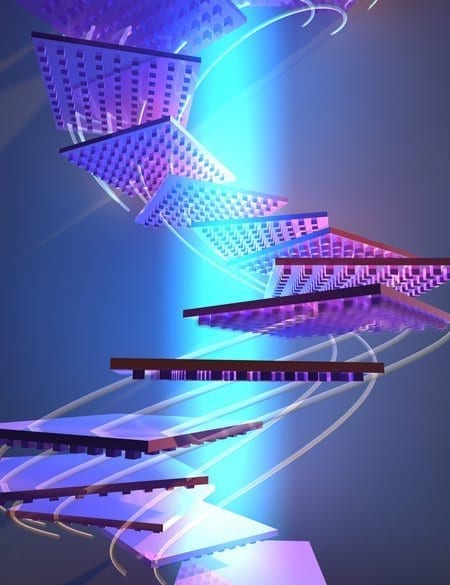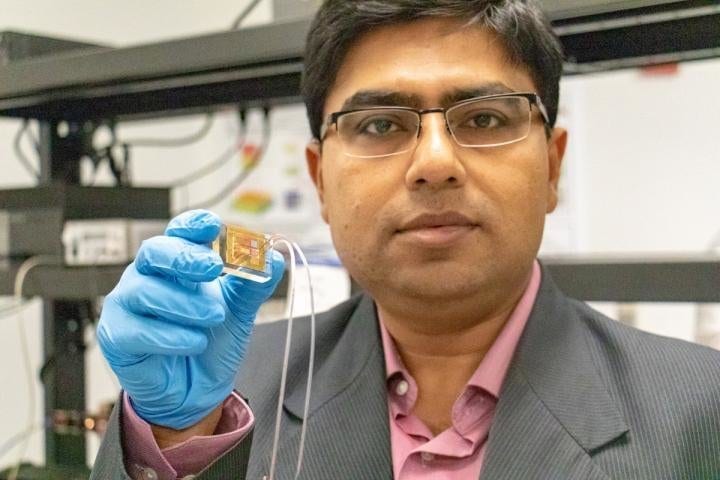
Credit: Courtesy of the Atwater laboratory
Nanoscale patterning could enable precise manipulation of objects on many scales.
Researchers at Caltech have designed a way to levitate and propel objects using only light, by creating specific nanoscale patterning on the objects’ surfaces.
Though still theoretical, the work is a step toward developing a spacecraft that could reach the nearest planet outside of our solar system in 20 years, powered and accelerated only by light.
A paper describing the research appears online in the March 18 issue of the journal Nature Photonics. The research was done in the laboratory of Harry Atwater, Howard Hughes Professor of Applied Physics and Materials Science in Caltech’s Division of Engineering and Applied Science.
Decades ago, the development of so-called optical tweezers enabled scientists to move and manipulate tiny objects, like nanoparticles, using the radiative pressure from a sharply focused beam of laser light. This work formed the basis for the 2018 Nobel Prize in Physics. However, optical tweezers are only able to manipulate very small objects and only at very short distances.
Ognjen Ilic, postdoctoral scholar and the study’s first author, gives an analogy: “One can levitate a ping pong ball using a steady stream of air from a hair dryer. But it wouldn’t work if the ping pong ball were too big, or if it were too far away from the hair dryer, and so on.”
With this new research, objects of many different shapes and sizes—from micrometers to meters—could be manipulated with a light beam. The key is to create specific nanoscale patterns on an object’s surface. This patterning interacts with light in such a way that the object can right itself when perturbed, creating a restoring torque to keep it in the light beam. Thus, rather than requiring highly focused laser beams, the objects’ patterning is designed to “encode” their own stability. The light source can also be millions of miles away.
“We have come up with a method that could levitate macroscopic objects,” says Atwater, who is also the director of the Joint Center for Artificial Photosynthesis. “There is an audaciously interesting application to use this technique as a means for propulsion of a new generation of spacecraft. We’re a long way from actually doing that, but we are in the process of testing out the principles.”
In theory, this spacecraft could be patterned with nanoscale structures and accelerated by an Earth-based laser light. Without needing to carry fuel, the spacecraft could reach very high, even relativistic speeds and possibly travel to other stars.
Atwater also envisions that the technology could be used here on Earth to enable rapid manufacturing of ever-smaller objects, like circuit boards.
Learn more: Levitating Objects with Light
The Latest on: Nanoscale patterning
[google_news title=”” keyword=”nanoscale patterning” num_posts=”10″ blurb_length=”0″ show_thumb=”left”]
via Google News
The Latest on: Nanoscale patterning
- Light Brought 'To a Halt' in Quantum Breakthroughon April 26, 2024 at 10:16 am
The bizarre feat can be achieved in special, two-dimensional crystals by deforming them only slightly, a new study discovered.
- Quantum leap: Scientists make light waves ‘stand still’on April 26, 2024 at 5:31 am
Scientists have discovered a novel method to manipulate light waves, using nanophotonics, by deforming the two-dimensional photonic crystal that contains them.
- Making light 'feel' a magnetic field like an electron wouldon April 24, 2024 at 7:29 am
Unlike electrons, particles of light are uncharged, so they do not respond to magnetic fields. Despite this, researchers have now experimentally made light effectively "feel" a magnetic field within a ...
- Photolithography Equipment Market Navigating Market Turbulence Future-Proofing Your Business Strategieson April 21, 2024 at 3:21 pm
Request To Download Free Sample of This Strategic Report @- Photolithography Equipment Market was valued at $8.04 billion in 2019 and is projected to reach $11.64 billion by 2027, registering a CAGR ...
- Lithography gets extremeon January 7, 2024 at 11:14 pm
As the pattern is transferred ... Belgium, and the College of Nanoscale Science and Engineering in Albany, New York. The ADTs function both as test environments for developments in EUV technology ...
- Nanophotonics – harnessing light at the nanoscaleon November 13, 2023 at 12:56 pm
Plasmonic metamaterials that squeeze light beyond the diffraction limit, allowing nanoscale waveguiding. Hyperbolic metamaterials enabling precise engineering of photonic density of states and ...
- The Different Types of Lithography in Nanotechnologyon June 16, 2023 at 11:43 am
The advent of nanotechnology further propelled this need, leading to the development of various forms of lithography that can pattern features at the nanoscale. From its humble origins in stone ...
- Recreating An Analog TV Test Patternon June 9, 2023 at 6:28 am
Some test patterns were simply camera feeds of physical cards, but if you wanted the most accurate and reliable test patterns you’d need a Philips pattern generator which created the pattern ...
- test patternon June 8, 2023 at 5:00 pm
We love that it shows the SMPTE color bars, aka the standard American TV test pattern as it switches between weather and news. After showing the top headlines, it automatically switches back to ...
- Zeroing in on the Elusive Green LED (2 of 2) (IMAGE)on May 22, 2022 at 11:57 am
Led by Professor Christian Wetzel, the research team etched a nanoscale pattern at the interface between the LED’s sapphire base and the layer of gallium nitride (GaN) that gives the LED its ...
via Bing News










